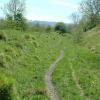35.002 Aproaerema cinctella (Clerck, 1759)
Status and Distribution
Very local in England and Ireland, scarce in south Wales, Northern Ireland and Scotland. The main concentration of confirmed records come from central-southern and north-east England and western Ireland. In view of its overall distribution, this species may be overlooked amongst the more widespread and common A. larseniella.
Pierce and Metcalfe (1935) showed that Syncopacma ligulella (since 1957 named S. larseniella) and S. vorticella (now called S. cinctella) were valid species. Prior to 1935, records of adult ligulella could possibly apply to either larseniella or cinctella. The name changes and lack of external identification features to separate these two species has led to misidentifications, a problem still present, to some extent, today.
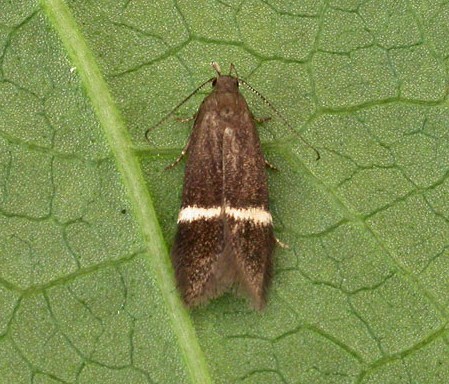
Provisional map
Foodplant and Larval Feeding Signs
Lotus corniculatus (common bird's-foot-trefoil), see plant distribution map. Possibly also Genista species.
In Europe it is also reported to utilise Genista germanica, Genista tinctoria (dyer's greenweed), Lembotropis nigricans, Medicago ssp. (medicks), Trifolium repens (also often seen flying over T. pratense) and Vicia cracca (tufted vetch). Apart from Trifolium repens, it is unclear if the other species are based on literatue alone or on confirmed bred specimens (Gregersen and Karsholt, 2022).
The reports of feeding between joined/united leaves are based upon larvae found in Europe which were written prior to the separation of A. cinctella from A. larseniella. No records on larval habit seem to be available (Gregersen and Karsholt, op. cit.).
Habitat
Finding the Moth
Larva: not recorded in Britain but believed to spin the leaves together.
Adult: has been swept from suitable habitat and occasionally comes to light.
Similar Species
There are six Aproaerema species that have a dark forewing and, to some extent or other, a whitish fascia; some are scarce and have a restricted distribution. The size of the moth together with the habitat and available larval foodplants will help to narrow down the options to some extent. Breeding to establish the association with a particular foodplant is strongly recommended and could possibly add additional information on the range of foodplants utilised by some of this genus. There is some overlap in foodplant usage and, if in doubt, bred specimens should also be dissected.
It has been suggested that the presence or absence of a curve to the whitish crossband can assist in identification of these species. This is not the case as, although A. larseniella normally has a straight line, both A. taeniolella and A. cinctella can have a straight or slightly inwardly curved fascia. This feature is therefore unsuitable on its own as an identification feature. It should also be noted that A. cinctella (in particular) and A. larseniella and A. taeniolella (to a much lesser extent) can lack the whitish fascia on the upperside of the forewing.
A. taeniolella, which also feeds on common bird's-foot-trefoil, usually has a narrow whitish fascia on the forewing underside, with a whitish spot on the underside of the hindwing. These features are not present in A. cinctella or other members of this genus. As A. larseniella has also been known to utilise common bird's-foot-trefoil on rare occasions, any Aproaerema bred from this foodplant without the white underside marking will require dissection to be identified with certainty. See photographs of A. taeniolella and A. larseniella usual forewing and hindwing undersides in 'Images' of the respective species.
A. cinctella may utilise some Genista sp. so the dissection of moths bred from this foodplant is also recommended.
A. cinctella and A. larseniella are the two most likely to cause confusion as they are very similar externally, with no external characters to reliably separate the two. A lack of critical examination of specimens in the past and, to some extent, more recently has made it difficult to accurately assess the true distribution of these two species. Although A. cinctella is believed to be more local and may well sometimes be associated with a different habitat, it is advised that habitat differences should not be used in isolation when making an identification until familiarity with the species present at a site have been ascertained by breeding and / or dissection. There is at least one southern English vice county where A. cinctella, A. larseniella and A. taeniolella are found regularly within one km or so of each other, including the forms of A. taeniolella with a broken or obsolescent white fascia on the upperside and underside of the forewing.
Structurally, A. cinctella has a relatively narrow forewing which appears broader towards the end, whereas A. larseniella does not appear to be broader at the end. The pale fascia on the forewing (sometimes absent in A. cinctella) is sometimes slightly inwardly curved in A. cinctella but can be straight as in A. larseniella - this is difficult to judge in a live moth and all of these features are best looked for in set specimens.
Single brooded, from late May to July.

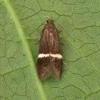
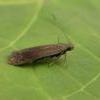
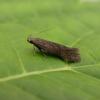
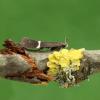
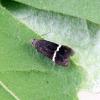
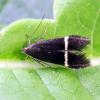
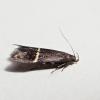
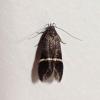
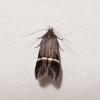
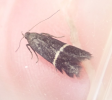
%20W%20Lothian%2025.5.24%20P%20Mapplebeck_0.jpg)
%20Renfrewshire%2025.6.24%20P%20Mapplebeck_0.jpg)
